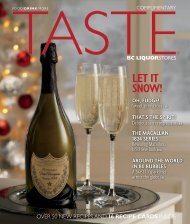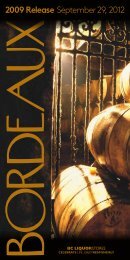Create successful ePaper yourself
Turn your PDF publications into a flip-book with our unique Google optimized e-Paper software.
ule 3<br />
be body coNscious<br />
Being body conscious makes the most<br />
satisfying couplings. I’m talking about<br />
wine and food here. Match a wine’s body<br />
to the richest component of the dish and<br />
you’re well on your way to a great fit.<br />
And given that a wine’s body is closely<br />
associated with its alcohol level, you can<br />
quickly determine the weight by a quick<br />
glance at the label – less than 12 percent<br />
alcohol and you’re talking light-bodied,<br />
12 to about 13 percent means mediumbodied<br />
and more than that creates a<br />
fuller-bodied wine. It’s pretty intuitive<br />
from there. Light-bodied whites like Pinot<br />
Grigio complement delicate fish dishes<br />
while a medium-bodied red such as a cassisscented<br />
Cabernet Sauvignon consummates<br />
that char-grilled steak and French fries.<br />
This rule is far more useful than simply<br />
matching a wine colour to the food.<br />
rule 4<br />
trade up<br />
Is there really a difference between a<br />
$15 and a $50 wine. Absolutely. As<br />
you trade up, you pay for better quality<br />
fruit – which translates to cleaner<br />
flavours – as well as more concentration,<br />
complexity and length. Dining in with<br />
friends, weekend dinners or whimsical<br />
celebrations all call for a slow approach<br />
to wine, which is good reason to trade<br />
up. Mid-week pizza nights, weekend<br />
barbecues and breezy cocktail-hours can<br />
probably accommodate $15 bottles where<br />
carefree quaffing is de rigueur.<br />
Even for everyday wines, trading up<br />
from a $10 bottle to a $15 bottle makes<br />
sense when you consider the math. Taxes,<br />
freight, duty and excise fees are fixed so<br />
wine in that $15 bottle is worth a higher<br />
percentage of the overall price than, that<br />
in a $10 one. So, when in doubt, trade up<br />
rule 5<br />
buy from a trusted producer<br />
Buying from a reliable producer means<br />
quite simply, the wine won’t let you<br />
down. And with California, the most<br />
trustworthy producers are the names<br />
behind the big brands like J. Lohr,<br />
Kendall-Jackson and Rodney Strong.<br />
Mondavi. Beringer. Clos du Bois. E&J<br />
Gallo. Big brands deliver great value for<br />
money, change very little year-to-year<br />
and sport clear, recognizable labels. No<br />
wonder they’re popular; they’re most<br />
likely to bring thunder to your life.<br />
HERE’S A CRASH COURSE IN THE MOST COMMON CALIFORNIA VARIETALS:<br />
uNOAKEd CHARdONNAY: Mixed citrus and apple<br />
OAKEd CHARdONNAY: Citrus with hints of vanilla, toast or butterscotch<br />
PINOT GRIGIO: Neutral aroma with slight lemon and floral flavour<br />
sAuvIGNON BLANC (also called Fumé Blanc): Lime, asparagus and gooseberries<br />
wHITE zINfANdEL (pink wine from red Zinfandel grapes): Peach and strawberry<br />
CABERNET sAuvIGNON: Blackcurrant, cassis and cedar<br />
MERLOT: Cherry and dark chocolate<br />
PINOT NOIR: Ripe raspberry and canned strawberries when young. Capable of<br />
changing dramatically when aged, taking on flavours of caramelised meat<br />
drippings, farm yard and truffle.<br />
sHIRAz (also called Syrah): Blackberry, black pepper, dark chocolate and smoke<br />
zINfANdEL (also called Primitivo): Blackberry, blueberry and peppercorn<br />
TASTE 51





